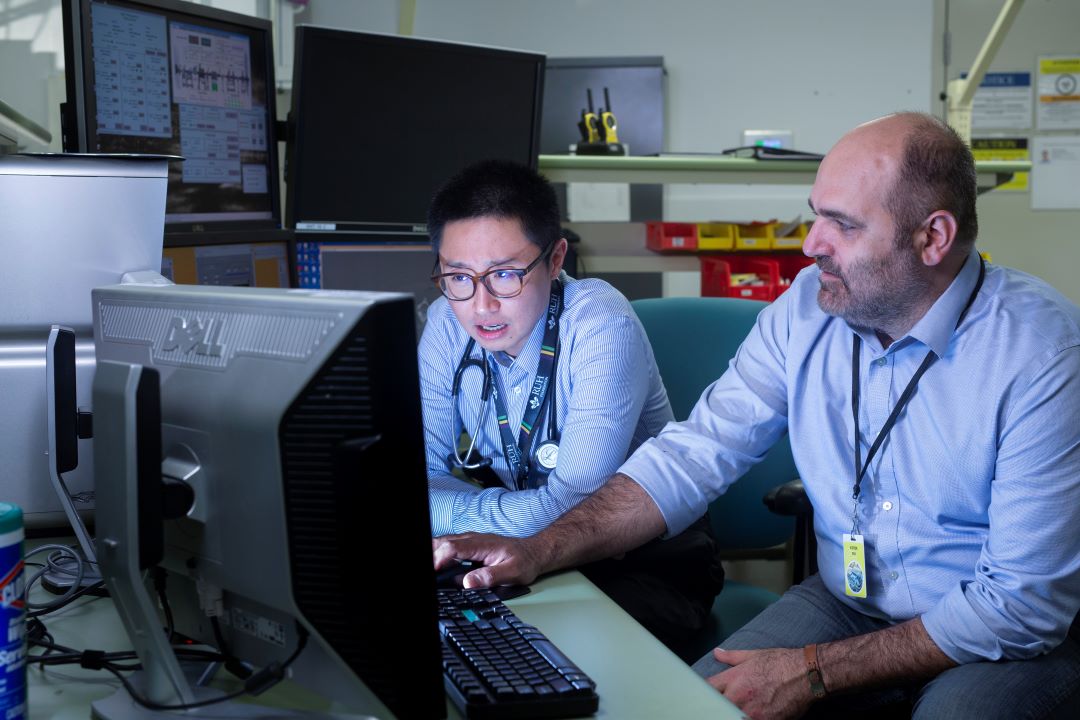Expanding the boundaries of collaboration
Achieving success by crossing traditional lines of collaboration, two partnerships at the College of Medicine offer insights into why these alliances are needed and how they can be fostered.
By Kate BlauJuan Ianowski and Julian Tam have partnered across the fields of biomedical science and clinical practice to achieve significant research success. Photo by Dave Stobbe
Partners for Patients
Building their partnership took time and diligence, but from the start Juan Ianowski and Julian Tam liked each other and got along well. That made the difference. Together, they have overcome the inherent hurdles in partnering across biomedical science and clinical practice and achieved significant research success.
Ianowski is a physiologist who leads research teams focused on foundational science at the molecular and cellular level. Tam is a respirologist whose days are primarily spent in a medical clinic working with a health care team on the front lines of patient care. While their days are very different, their work shares a common focus: cystic fibrosis (CF).
In 2015, Ianowski learned that Tam had joined the College of Medicine faculty. Knowing that working with a CF clinician would expand his research plans and capabilities, he reached out to Tam and they met for coffee.
“Although we became friends shortly after meeting, it took us a while to really learn to speak the same ‘scientific language,’” Tam said. “I admitted to him early on that I wasn’t able to see how his research would impact my clinical practice.”
Although he was a medical expert in CF, Tam found that Ianowski’s basic research on the details of CF challenged his understanding of the topic.
“Juan was very patient with me and took time to answer my questions. After reading, discussing and learning more, I grew to understand the significance of his research findings in the context of patient care. I view CF and new treatments differently now as I have a fuller understanding of their mechanism.”
For Ianowski, the interaction is providing the benefits he sought.
“Biomedical researchers working in human disease seldom have contact with the clinic or witness a clinician-patient interaction. So the patient is an abstraction,” he said. “I had the good fortune of shadowing Julian on a few visits with patients that have fundamentally altered my approach to my research and made ‘the patient’ real. My goal is to continue producing innovative hypotheses and results, as I should, but in the new context of being involved in the CF clinic.”
Ianowski feels his interactions with patients have had a much larger effect on him than his work has had on them so far. Tam said he finds that patients are interested in hearing about current CF research and appreciate having a researcher interested in learning from them. They are hopeful that direct patient benefits are not far away, with a few projects related to therapeutics underway they believe will contribute
to patient health in a few years.

One of the greatest benefits of the partnership that both rely on is keeping in close touch. They connect daily via phone calls and email and typically meet at least twice a week.
“We discuss every aspect of research,” Ianowski said, “literature, proposing new ideas and hypotheses, discussing results, discussing future experiments and their design, and so on. Once a month or so, Julian comes to one of the weekly meetings I run in my laboratory where the students present their progress. A few times a month I shadow Julian with patients. Finally, Julian and I co-supervise students.”
Said Tam, “We are good friends and want to see each other succeed. We have a similar work ethic. We are willing to meet on short notice to discuss issues and findings. Importantly, we share an interest in cystic
fibrosis. We both want to advance understanding of the condition and develop better treatments for it.”
Earlier this year, their groundbreaking finding on what actually takes place in the lungs when a concentrated salt solution is inhaled—a treatment that’s been used for CF patients for more than 20 years— was published in the online Nature Research journal Scientific Reports. They used synchrotron imaging at the Canadian Light Source to learn more about what was taking place in the lungs. The new understanding could pave the way for improved treatments.
“I think that Julian’s generosity with his time and ideas and willingness to allow me to be part of the CF clinic was crucial for our success,” Ianowski said.
While this success, their shared research interest and friendship continue to fuel the partnership, both agree it’s exceptional. They believe more partnerships like theirs are worth pursuing and could be
made easier.
“Our working relationship developed organically,” said Tam. “We have shared research interests and were not forced to work together. However, as a busy clinician, having time to collaborate is helpful.”
“Basic researchers and clinicians work in separate buildings and departments in our college,” said Ianowski. “As a result, it is entirely possible that there are basic researchers and clinicians working on the same disease in the college and they do not even know of each other. This is a lost opportunity.”
He suggests that clinicians be ensured more time for research and the profile of basic science researchers be enhanced and more visible to clinical departments. He feels it would be beneficial if researchers could change departments more easily as their research interests develop over time.
This is part one of a two part story. Read part two. It first appeared in the Fall 2019 edition of Connective Issue.
